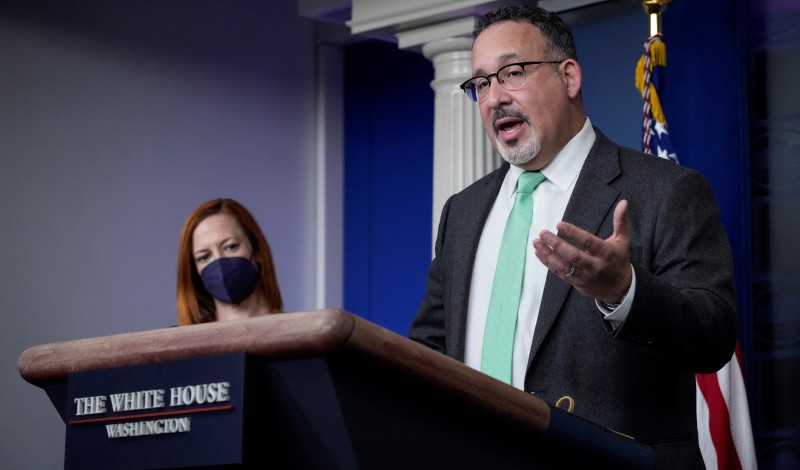
The Secretary of Education’s legal authority to grant across-the-board loan forgiveness is unclear.
Earlier this month, White House Chief of Staff Ron Klain revealed that President Joseph R. Biden has requested that Secretary of Education Miguel Cardona prepare a policy memorandum exploring whether the Secretary has statutory authority to forgive student loan debt of up to $50,000 per borrower. To respond to this request, Cardona and his staff will have to dig into a legal morass worthy of a law school examination.
Superficially, the question seems a simple one. Everyone agrees that the Secretary of Education is empowered to make adjustments on federal student loans. The debate turns on the precise meaning of provisions of the Higher Education Act of 1965 (HEA) which confer upon the Secretary the power to “consent to modification” of, and to “compromise, waive, or release,” amounts due on certain student loans. These powers are often referred to as the Secretary’s “compromise authority.”
Advocates of broad executive authority to forgive student loans see in these provisions unbridled discretion—that is, plenary compromise authority. Under this view, the Secretary can forgive any amount of student debt, including debts of borrowers perfectly capable of repaying their loans.
The alternative—and traditional—view is that these provisions grant only constrained compromise authority, available where borrowers lack the financial capacity to service their student loans or other equitable considerations warrant debt relief. The parameters of constrained compromise authority are not clearly defined. For example, it is not obvious under the traditional view the extent to which the COVID-19 pandemic could be deemed a factor warranting forgiveness for affected borrowers. Still, advocates of this interpretation stress the importance of some sort of individualized determination to justify forgiveness.
The language of the HEA itself is ambiguous. Those favoring plenary compromise authority can focus on more open-ended language, such as the words “release” and “waive.” For traditionalists, the prominence of the word “compromise” in various parts of the HEA suggests a requirement of at least some sort of give-and-take that is absent in blanket forgiveness.
Similarly, the word “modify” can connote modest adjustments, although it might also be understood to embrace full forgiveness. This kind of indeterminacy might lead some lawyers to conclude that the courts should defer to the Secretary’s own interpretation of the language, thus allowing Cardona to embrace plenary compromise authority.
At least four contextual considerations, however, weigh against this conclusion.
First, Congress has authorized numerous student loan forgiveness programs. These have been defined in quite explicit and precise terms, limiting the conditions under which the Secretary is authorized to forgive student loans to various borrower characteristics and loan terms. Over the years, Education Secretaries have occasionally pushed the boundaries of these limits, but they have always proceeded under the assumption that statutory limits are binding. Yet, under the plenary compromise view, the explicit restrictions in these statutory programs would be treated as optional because the Secretary of Education purportedly has complete discretion to ignore any statutory restrictions on loan forgiveness.
Second, there is no direct historical support for the proposition that Congress intended to grant the Secretary of Education plenary compromise authority when it initially enacted the statutory language authorizing the Secretary to modify and release loans. These compromise provisions were adopted back in 1965 when Congress imported language that it had adopted shortly after World War II to govern Veteran Administration (VA) loan guaranty programs. In response to quite reasonable requests for statutory authority to resolve claims administratively rather than through cooperation with the U.S. Department of Justice, Congress granted loan compromise authority first to the VA and later to the U.S. Department of Education.
In 1966, Congress enacted the Federal Claims Collection Act (FCCA), a more general statute governing all federal agencies and establishing a more fully articulated system for resolving disputed claims with the federal government including provisions that expressly addressed how agencies should deal with financially constrained counterparties.
The FCCA adds another wrinkle to the debate over Education Department compromise authority. On the one hand, advocates of constrained compromise authority see in the FCCA an indication of how Congress in the mid-1960s expected executive agencies to proceed with debt collections: namely, they should aggressively pursue claims, but allow for commercially reasonable settlements when circumstances require.
On the other hand, proponents of plenary compromise authority counter that the absence of specific limitations on the HEA provisions demonstrates a congressional intent to grant the Education Department broader compromise authority. But there is no direct evidence in the legislative history of the HEA that Congress understood the Secretary of Education’s compromise authority to be so far-reaching, and certainly, that interpretation would not have been necessary to achieve the efficiency goals that the compromise authority was introduced to provide. Moreover, experts charged with overseeing federal collection practices at the time expressly disavowed the possibility that agencies with independent compromise authority, such as the Education Department, could unilaterally terminate debts.
A third challenge to the argument for plenary compromise authority rests with the U.S. Constitution, which grants Congress both the exclusive power of the purse under the Appropriations Clause and the exclusive authority to dispose of government property under the Property Clause. In recognition of Congress’s prerogatives with respect to federal resources, the courts have demanded that executive authority to spend federal dollars be explicitly granted to agencies and not inferred from ambiguous statutes or by implication. In recent years, this principle has been reaffirmed as being of particular importance in the area of entitlements, which includes the vast majority of student loans, where Congress does not regularly revisit spending decisions through annual appropriations.
But when did Congress explicitly authorize the Secretary of Education to expend federal resources by forgiving claims due on student loans owed by solvent borrowers? At root, proponents of plenary compromise authority must defend the proposition that Congress in 1965 effectively authorized the expenditure of what could be in excess of $1 trillion of public resources over the next few years by granting the Secretary unbridled compromise authority. To say the least, that grant of authority was not explicit and is far from clear.
The lack of clarity continues to affect budget policy today. In the recently adopted stimulus bill, for example, Congress included provisions waiving federal income tax liability for student loan debt forgiveness. The Congressional Budget Office scored this provision as costing the federal government only tens of millions of dollars. If, however, the Secretary possesses and acts upon plenary compromise authority here, the actual cost of that tax provision would be in the tens or even hundreds of billions of dollars.
The fourth challenge confronting the proponents of plenary compromise authority stems from the Education Department’s own regulations, which the agency amended in 2016 to incorporate the FCCA’s standards for loan forgiveness into the Department’s lending programs. So even if the Secretary were free under the statute to take a different approach to student loan forgiveness, the Department would appear to be bound at present by its own regulations imposing limitations that are inconsistent with plenary compromise authority. Proponents of broad-based loan forgiveness have assembled arguments as to why these regulations should not be read to mean what they seem to say. But the presence of these regulations could complicate the Department’s ability to defend broad-based forgiveness in court.
In short, the question of the Secretary’s authority to forgive student loans is a complicated one. A plausible textual reading of statutory language in favor of plenary compromise authority exists, but it must be balanced against a rather substantial amount of contextual considerations that point in the direction of constrained compromise authority.
How, then, should Cardona proceed? No doubt some advocates will favor having the Secretary charge ahead and assert plenary compromise authority on the basis of textual arguments.
Admittedly, student debt has become a substantial burden on many borrowers. A mounting percentage of such debt was already non-performing when the pandemic struck, and non-performance can only increase once the current moratorium on payments expires. One cannot help but sympathize with plenary authority proponents who seek the most expansive forms of relief, especially in the aftermath of the Trump Administration’s willingness to advance legal positions with much weaker statutory bases.
On the other hand, there will be considerable political and legal risks associated with pushing ahead precipitously, and a strong possibility that the initiative might be tied up in court for many years, only to be resolved by a not wholly sympathetic Supreme Court. And, of course, there is also the—perhaps old-fashioned—notion that agencies should try to advance the best reading of statutes, not the one that is most congenial to the President’s preferences.
Were we advising the Secretary, we would recommend that the matter be addressed—at least initially—through the rulemaking process. At a minimum, the rulemaking process could clarify the extent to which the Secretary intends to be governed by the requirements of the FCCA going forward.
Equally important, a rulemaking procedure would allow the Department the opportunity to craft a student loan forgiveness program that incorporates some degree of individualized determinations. Especially if such a program were advanced through notice-and-comment rulemaking, the Secretary would be better equipped to defend his position as a reasonable interpretation of a constrained compromise authority and avoid altogether the doctrinal challenges of defending plenary compromise authority.
In a perfect world, Congress might well be asked to address the issue through statutory clarification. But with the challenges confronting Washington, D.C., and the impediments to any form of legislative action, an executive response to student debt relief has its appeal. Still, the better course is to frame that relief as an exercise of constrained compromise authority implemented through notice-and-comment rulemaking.
This essay is based on the authors’ paper, available online as “May the Executive Branch Forgive Student Loan Debt Without Further Congressional Action?”





